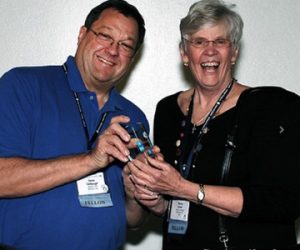1929 — 2020
by Amy Kronenberg

Born 5 October 1929 in Boston, Massachusetts, John B. (Jack) Little passed away on Sunday, 24 May 2020. He was an outstanding scientist who made seminal discoveries in radiation biology and cancer biology, including mechanistic aspects of DNA repair, mutagenesis, genomic instability, and other nontargeted effects of exposure that each influence radiation response. Dr. Little was the director of the John B. Little Center for Radiation Sciences and Environmental Health and of the Kresge Center for Environmental Health at the Harvard School of Public Health (now the Harvard T.H. Chan School of Public Health), where he served as chairman of the Department of Physiology and the Department of Cancer Cell Biology. Little was the James Stevens Simmons Professor of Radiobiology until his retirement.
Little earned his AB in physics from Harvard University in 1951 and an MD from Boston University in 1955. He did his internship on the Osler Service at the Johns Hopkins Hospital, and then served as a US Army Captain in the Medical Corps in Texas and in Bussac, France. He completed his training in radiology at Massachusetts General Hospital and was board certified in radiology. Little served as a consultant in radiology at the Massachusetts General Hospital starting in1965. He became an instructor in radiobiology at Harvard in 1963, where he spent the remainder of his remarkable career.
An inveterate collector and tinkerer, Little had an impressive collection of old radios, televisions, medical instruments, and cars. His office, on the corner of the second floor of Building 1 at what is now the Harvard T.H. Chan School of Public Health, contained a wealth of curious equipment and the careful maintenance and nurturing of old x-ray machines was also a specialty of Little's laboratory. When, after four decades, the second floor was to be remodeled, his personal correspondence was moved to the Countway Library, and the collection of antique medical equipment and inventions made by Little was donated to the Historical Instruments Collection in Cambridge.
Little was first elected to the National Council on Radiation Protection and Measurements (NCRP) in 1991 and became a Distinguished Emeritus Member in 2009. During his tenure, he served as a member of Scientific Committee 1 and as a consultant to Scientific Committee 83. He was also a member of the 1996 Annual Meeting Program Committee. Little's outstanding contributions to the field of radiation protection were recognized by his selection as the Lauriston S. Taylor Lecturer in 2005. Little's Taylor Lecture, delivered at the NCRP annual meeting, was titled "Nontargeted Effects of Radiation: Implications for Low Dose Exposures."
Little was a recipient of the Radiation Research Society Failla Award in 1994 and the Henry S. Kaplan Distinguished Scientist Award from the International Association for Radiation Research in 1999. Little was a member of the Radiation Research Society and served as its president from 1986 to 1987 and was a member of the American Association for Cancer Research, the American Physiological Society, the American Society for Photobiology, and the Health Physics Society. He authored or coauthored more than 525 scientific papers and holds a patent for "Cell Lines and Methods for Assaying Human Interchromosomal Recombination."
He was chairman of the Board on Radiation Effects Research, Commission of Life Sciences, National Research Council, National Academies from 1992 to 1998; chairman of the Science Council of the Radiation Effects Research Foundation in Hiroshima from 1992 to 1998; a member of the International Commission on Radiological Protection Committee 1; and chairman of the Board of Scientific Councilors of the National Institute of Environmental Health Sciences, among many other international panels, editorial boards, and committees.
Little's biography includes holding a National Institutes of Health (NIH) Outstanding Investigator Award from 1988 to 2000 in recognition of his visionary science. However, perhaps his most important accomplishment was his inspired leadership of an NIH radiation biology training grant starting in 1975. Over his extraordinary career, Little mentored more than 250 individuals from all over the world, including undergraduate students, doctoral candidates, postdoctoral fellows, and clinician-scientists. His trainees nominated him for the first Scholar-in-Training Excellence in Mentoring Award from the Radiation Research Society, which he was awarded in 2005. Many of his trainees are themselves leaders in the fields of cancer biology, radiation biophysics, radiation oncology, occupational health, public health, and science education. Sixteen of Little's trainees have become department chairs at their various institutions, and two are now university deans.
In 1998, the first annual symposium of the John B. Little Center for Radiation Sciences and Environmental Health was organized, funded by a generous gift from his former trainee Dr. Gerald Chan. In addition to providing a venue for scholarship, these "JBL Symposia" also serve as a focal point for reunions of former members of Little's extended laboratory family who bring their students, share recipes from "Christmas in July" gatherings at Little's home, and dream up ideas for future collaborations.
The Health Physics Society extends its condolences to his wife, Françoise; children, John and Frédéric; daughters-in-law Pamela and Claudia; and five grandchildren.






